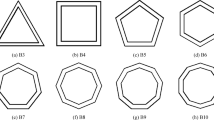Abstract
This work introduces a new approach to targeting the dynamic response of thin-walled energy-absorbing structures through the decomposition of the force-displacement (FD) response and the use of topometry (thickness) optimization. The proposed method divides the nonlinear optimization problem into a series of analytical subproblems. In each iteration, an explicit dynamic analysis is carried out and the dynamic response of the structure is then used to define the subproblem. Numerical examples show that the algorithm can tailor the FD response of the structure to a target FD curve. Progressive collapse, which is a high-energy collapse mode and desired in design for crashworthy, is observed in the optimized thin-walled structures. The proposed algorithm is computationally efficient as it uses a fewer explicit simulations to reach the target response.






















Similar content being viewed by others
References
Bandi P, Detwiler D, Schmiedeler JP, Tovar A (2015) Design of progressively folding thin-walled tubular components using compliant mechanism synthesis. Thin-Walled Struct 95:208–220
Baroutaji A, Sajjia M, Olabi A-G (2017) On the crashworthiness performance of thin-walled energy absorbers: recent advances and future developments. Thin-Walled Struct 118:137–163
Duddeck F, Hunkeler S, Lozano P, Wehrle E, Zeng D (2016) Topology optimization for crashworthiness of thin-walled structures under axial impact using hybrid cellular automata. Struct Multidiscip Optim 54(3):415–428
Guler MA, Cerit ME, Bayram B, Gerceker B, Karakaya E (2010) The effect of geometrical parameters on the energy absorption characteristics of thin-walled structures under axial impact loading. International Journal of Crashworthiness 15(4):377–390
Hallquist J. (2006). LS-DYNA theoretical manual, Livermore Software Technology Corporation (LSTC)
Jones N. (1997). Structural impact, Cambridge University Press, Cambridge, England
Kim YI, Park GJ (2010) Nonlinear dynamic response structural optimization using equivalent static loads. Computer Methods in Applied Mechanics & Engineering 199(9):660–676
Leiva J.P. (2004). Topometry ioptimization: a new capability to perform element by element sizing optimization of structures. AIAA/ISSMO Multidisciplinary Analysis and Optimization Conference
Lu, G.X., Yu, T.X. (2003). Energy absorption of structures and materials, M. Woodhead Publishing Limited, Abington Cambridge CB1 6AH, England. pp. 26–32
Mozumder C, Renaud JE, Tovar A (2012) Topometry optimisation for crashworthiness design using hybrid cellular automata. Int J Veh Des 60(1–2):100–120
Mozumder, C, Tovar, A., Renaud, J.E. (2010). Topometry optimization of plastically deformable sheet-metal structure with prescribed force-displacement response for controlled energy absorption. 8th World Congress on Structural and Multidisciplinary Optimization, Lisbon, Portugal
Park GJ (2011) Technical overview of the equivalent static loads method for non-linear static response structural optimization. Struct Multidiscip Optim 43(3):319–337
Park GJ, Kang BS (2003) Validation of a structural optimization algorithm transforming dynamic loads into equivalent static loads. Journal of Optimization Theory & Applications 118(1):191–200
Patel, N.M. (2007). Crashworthiness design using topology optimization. PhD thesis, University of Notre Dame, Indiana
Patel NM, Kang BS, Renaud JE, Tovar A (2009a) Crashworthiness design using topology optimization. J Mech Des 131(6):061013
Patel, N.M., Penninger, C.L., Renaud, J.E. (2009b). Topology synthesis of extrusion-based nonlinear transient designs. ASME J Mech Des, 131(6):061003–061011
Pedersen CBW (2003) Topology optimization design of crushed 2d-frames for desired energy absorption history. Struct Multidiscip Optim 25(5–6):368–382
Penninger CL, Patel NM, Niebur GL, Tovar A, Renaud JE (2013) A fully anisotropic hierarchical hybrid cellular automaton algorithm to simulate bone remodeling. Mech Res Commun 35(1):32–42
Penninger CL, Watson LT, Tovar A, Renaud JE (2010) Convergence analysis of hybrid cellular automata for topology optimization. Struct Multidiscip Optim 40(1–6):271–282
Shin MK, Park KJ, Park GJ (2007) Optimization of structures with nonlinear behavior using equivalent loads. Computer Methods in Applied Mechanics & Engineering 196(4):1154–1167
Tovar, A. (2004). Bone remodeling as a hybrid cellular automaton optimization process. PhD thesis, University of Notre Dame, Indiana
Tovar A, Patel NM, Niebur GL, Sen M, Renaud JE (2006) Topology optimization using a hybrid cellular automaton method with local control rules. J Mech Des 128(6):1205–1216
Witowski, K., Mullerschon, H., Erhart, A., Schumacher, P., Anakiev, K. (2014) Topology and topometry optimization of crash applications with the equivalent static load method. 13th International LS-DYNA Users Conference, Dearborn, MI
Zeng D, Duddeck F (2017) Improved hybrid cellular automata for crashworthiness optimization of thin-walled structures. Struct Multidiscip Optim 56(1):101–115
Author information
Authors and Affiliations
Corresponding author
Additional information
Responsible Editor: Somanath Nagendra
Publisher’s Note
Springer Nature remains neutral with regard to jurisdictional claims in published maps and institutional affiliations.
Rights and permissions
About this article
Cite this article
Han, X., An, W. & Tovar, A. Targeting the force-displacement response of thin-walled structures subjected to crushing load using curve decomposition and topometry optimization. Struct Multidisc Optim 59, 2303–2318 (2019). https://doi.org/10.1007/s00158-019-02197-8
Received:
Revised:
Accepted:
Published:
Issue Date:
DOI: https://doi.org/10.1007/s00158-019-02197-8




